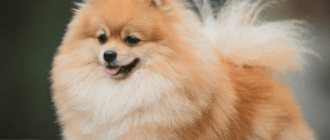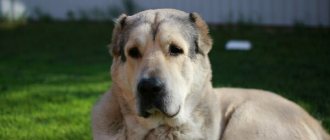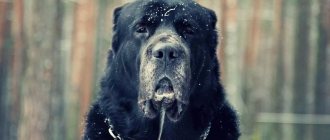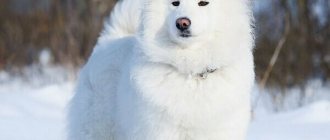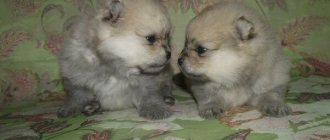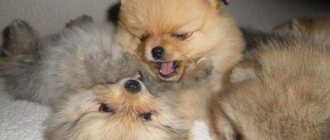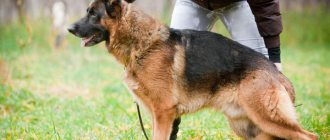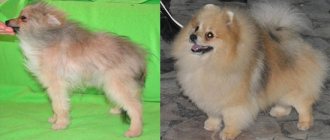Pomeranians are small, very beautiful and fluffy dogs that may appear somewhat larger due to their long and thick coat, which visually gives them additional volume.
It is very important for owners of such pets to know how much their Spitz weighs.
The size and weight of a dog is of considerable importance not only for an exhibition career, but also for the health of Pomeranians.
And, of course, puppy owners need to especially carefully monitor how their pet grows and develops.
Origin of the breed
You can find rare mentions of the existence of the Spitz back in the times of Ancient Greece and Ancient Rome. However, the breed was not popular until the Middle Ages. Then the dog was used as a guard. In rare cases, adult Spitz dogs were taken on hunts to drive animals. The dog had no decorative value.
The name of the Pomeranian comes from the historical region of Germany - Pomerania. It is believed that it was there that they began to engage in professional breeding of the breed. However, some sources claim that at that time Spitz were already selected in Holland, Denmark and Finland. And in Siberia, Spitz-shaped huskies were popular.
Breeding the dwarf form of the adult Spitz began in England during the time of Queen Victoria. Breeders paid special attention to the size of the dog, the beauty of its coat and overall appearance. To this day, English representatives of the breed are the standard of grace, forcing other breeders to strive for the same results.
Spitz breed varieties
There are several varieties of the Spitz breed. And each has its own characteristics and distinctive features. Here are some of the types:
- Pomeranian;
- German;
- Finnish;
- Italian, or Volpino Italiano;
- Japanese;
- American Eskimo;
- Greenlandic;
- Karelian Bear Dog or Karelian Bear Laika;
- Eurasian Spitz;
- Karelian-Finnish Laika.
The smallest breed is the Pomeranian Spitz.
Coat type and color
The Dwarf Spitz has become so popular due to its coat. The Pomeranian Dwarf Spitz breed has a double coat: guard and down. The wool is elastic and very dense. On the body of the animal it is usually longer.
An adult dog has a well-developed collar. There may also be “pants” and “feathering”, which is observed on the back of the front legs. All Pomeranians go through a period when their coat looks unpresentable. This is usually typical during adolescence. For an adult animal, this type is considered a marriage. This characteristic of the breed is not known to many dog breeders.
Mini Spitz have fewer colors than those listed in the FCI standard.
The Pomeranian variety is often associated with the color red. However, they are also characterized by the following colors: black, zonal (gray), white, as well as orange, brown and cream. The most common are red and white Spitz, as well as gray dogs.
Adult Pomeranian Spitz: photos, characteristics
The appearance of the breed is distinguished by its thick coat with a fluffy undercoat. The beauty of the “fur coat” will largely depend on proper care for it. An attractive feature of an adult Spitz dog is its fluffy tail, curled in a ring and lying on its back. The cuteness is caused by small, close-set button eyes, a fox nose, protruding ears and thick “pants” on the hind legs.
The size of an adult Pomeranian Spitz varies from 18 to 22 cm at the withers. The dog weighs from 1.5 to 3.5 kg.
Health and life expectancy
The Pomeranian Spitz, like many other breeds, is prone to breed-related illnesses. Therefore, the dog must be shown to the veterinarian regularly. Puppy and adult Pomeranian dwarf Spitz may suffer from the following pathologies:
- atlantoaccipital subluxation. Leads to disruption of the development of the cervical vertebrae. Other types of dislocations are also typical;
- hypothyroidism (underfunction of the thyroid gland);
- tracheal collapse (genetic disease);
- eye diseases: cataracts, entropion;
- testicular tumors;
- cryptorchidism (males suffer).
We recommend this article:
What diseases are small Spitz dogs susceptible to?
This breed also has difficulties with childbirth. All the ailments characteristic of this breed arose due to the fact that breeders wanted the Pomeranian to be small in size. But in such a miniature lies a wide variety of health problems. As you can see, the Pomeranian Spitz has a lot of health problems. But if cared for correctly, a dog of this breed can live about 12–16 years.
We recommend this article:
What is the difference between a Pomeranian and a German Spitz and who is better?
Adult German Spitz
There are 4 varieties of German Spitz, each of which has its own distinctive characteristics:
1. Kleinspitz is the smallest representative of the breed. The dog has a mischievous disposition, active behavior and loud barking, which may turn off some potential owners. Despite its size, an adult Spitz dog copes well with the role of a watchdog. The pet is devoted to its owner and can become a wonderful friend. Below is a photo of an adult Spitz dog.
2. Mittelspitz is a medium-sized variety of German breed. Thanks to incredible optimism and playfulness, the dog will require long walks outside from its owners. The pet loves to play and does not mind if children keep him company. With proper training, the dog will use a loud bark only when necessary.
3. The Grossspitz is a large German breed. Among all other Spitz dogs, this variety is distinguished by its special kindness and affectionate attitude towards others. For children, the Grossspitz will become a true friend, companion and guard, with whom it will be impossible to part. The beautiful appearance attracts special attention to the four-legged dog from people, even those who, in principle, are indifferent to dogs. The kindness of the Gross Spitz allows the four-legged pet to get along with other animals. Representatives of this breed have another positive trait - intelligence and ingenuity. This will make the training process fun and simple.
4. Keeshond is the largest representative of the German Spitz breed. The appearance of the animal resembles a wolf, which is a distant ancestor of the Keeshond. This ancient breed was bred to guard homes, barns, ships and barges. Perhaps this is the reason that Keeshonds love to swim. Despite its formidable appearance and size, the dog is friendly, sociable, loyal and restrained in its emotional outbursts, although it is prone to jealousy. The Keeshond treats strangers with some caution and suspicion, which makes him a good watchdog. A distinctive feature of the animal is also its independence and self-confidence.
The size of an adult German Spitz varies from 23 to 55 cm at the withers. The dog weighs from 7 to 18 kg.
Flaws
There are also significant disadvantages:
- Taking long walks every day takes time.
- The diet for a dog is quite expensive.
- High price for a puppy.
- Loneliness has a negative impact on the psyche; a dog requires time and communication.
Owning a Pomeranian can take a big toll on your wallet.
Adult Finnish Spitz
A wonderful representative of the breed. The dog is considered quite large among its brothers, so the Finnish Spitz is often taken for hunting. The four-legged animal is quite capable of coping with small animals or birds.
Representatives of the breed are distinguished by their restlessness, playfulness and loud barking, which can be heard quite often. And loyalty to the owner is beyond doubt.
The size of an adult Finnish Spitz varies from 40 to 50 cm at the withers. The dog weighs from 7 to 13 kg.
Disease susceptibility
The following genetically determined anomalies and pathologies occur in Spitz dogs: false polydontia, tracheal collapse, patent ductus arteriosus, medial luxation of the patella, cryptorchidism, portosystemic shunts; puppies often have sensitive digestion.
With age, Spitz dogs may develop: heart valve disease (endocardiosis), tartar, chronic rhinitis and laryngotracheitis. The Spitz is prone to heat stroke and skin inflammation.
In any case, it is worth remembering that there is no breed of dog whose representatives never get sick. It is important to buy puppies only from trusted breeders from parents with healthy pedigrees. This minimizes the likelihood of genetic pathologies. To prevent diseases, it is necessary to carry out a general medical examination of your pet at least once a year.
Adult Italian Spitz, or Volpino
This small, extremely playful dog has a restless character. The Italian is very emotional and reacts to all events with a loud bark. But good nature and responsiveness allow you to close your eyes to the overly absurd temperament of your four-legged friend.
The size of an adult Volpino varies from 25 to 30 cm at the withers. The dog weighs no more than 5 kg.
Adult Japanese Spitz
The snow-white beauty is distinguished not only by its amazing color, but also by its dislike of barking. The pet uses its voice extremely rarely, only when necessary. A Japanese adult can be an excellent nanny, as he loves children and is willing to spend a lot of time with them. The dog is kind, active, able to create a positive atmosphere in the house, and playful.
The size of an adult Japanese Spitz varies from 35 to 40 cm at the withers. The dog weighs from 6 to 10 kg.
Adult American Eskimo Spitz
A distinctive feature of the “Eskimo” is a distrustful attitude towards strangers, therefore, if the owner wants to raise a dog that makes good contact, the animal should be socialized as early as possible. A photo of an adult Spitz is presented below.
The American Eskimo Spitz, like its other brothers, is active and charismatic. A dog can serve a person both as a watchdog, on a hunt, and simply as a four-legged friend.
The size of an adult American Eskimo varies from 22 to 49 cm at the withers. The dog weighs from 8 to 16 kg.
Adult Greenland dog
The Spitz of this breed is considered a sled dog. In the old days, Greenlanders were taken to hunt large northern animals. And although in recent years the need for this has decreased, representatives of the breed have not lost their courage, endurance, and daring temperament.
The size of an adult Greenland dog varies from 50 to 60 cm at the withers. Weighs from 30 to 32 kg.
What to do if your weight is below normal
A slight lag in weight from the norm (5-10% of body weight) is not an indicator of abnormal development of the puppy. The baby probably has lighter bones, or maybe he is simply not growing quite evenly: first he gains height, and then body weight.
The main criterion in this case should be the well-being and activity of the pet..
IMPORTANT!
When your puppy is cheerful, playful, and willing to learn new commands, there is usually nothing to worry about. If the ribs can be felt, but not too clearly, and the muscles are elastic and strong, then the dog is in good condition.
If the weight gap exceeds 10% of the recommended norm, then measures need to be taken. You may have to increase the calorie content of your food or change the brand of food.
If the lag in weight is due to improper rearing or the Pomeranian, as a puppy, suffered from something serious, you cannot do without consulting a veterinarian.
In some cases, increasing the duration of walks and the intensity of physical activity will also be useful, especially if the dog previously led a sedentary lifestyle..
In order to know exactly how the pet’s growing up process will proceed, it is recommended to ask the breeder about how the dogs of the lines to which the baby’s father and mother belong to grow and develop.
Adult Karelian Bear Dog or Karelian Bear Laika
In appearance, the Karelian Bear Dog is more similar to a husky than a Spitz. The breed is distinguished by its large size and color. The color of the coat, which is not as thick and long as that of standard Spitz dogs, is most often dark.
The hunting skills of an adult bear-type Spitz are manifested in an active, courageous character, unpretentiousness in food and lifestyle. Your four-legged friend should be socialized from a very early age. This also applies to training. The enviable courage of a dog without proper training can manifest itself in an aggressive attitude towards strangers and other animals.
The size of an adult Karelian bear husky varies up to 60 cm at the withers. Weighs from 17 to 28 kg.
Factors influencing growth
Puppies of the same breed and even the same litter develop differently. Someone seems to repeat standard norms, someone surpasses them, and someone lags behind their peers. Some puppies grow, gain weight in leaps and bounds, while others are in “waiting mode” for a long time in order to catch up and even surpass their sisters and brothers in a matter of weeks.
There are several reasons for this uneven growth:
- Genetic predisposition. Often, a miniature Spitz, having matured, can confidently compete in weight with a standard one. To avoid such a surprise, you should thoroughly study its pedigree before purchasing a puppy.
- Nutrition. Puppies that have the same weight at birth can vary greatly in weight after just a couple of months. One of the main reasons for this phenomenon is the diet and feeding schedule. According to the observations of breeders, puppies on natural food surpass the general indicators, and puppies on dry food develop more harmoniously, practically repeating the standard.
- Physical activity. The more the puppy moves, the more active games in his life, the more harmonious the development. In such an animal, the skeleton is strengthened faster and muscle mass is formed faster. An active dog with normal nutrition will never suffer from obesity or dystrophy.
- Vitamin and mineral supplements. For the harmonious development of a small Spitz, high-quality natural food or professional food is not enough. The animal is offered vitamin and mineral complexes - of the names and dosages that were prescribed by the veterinarian.
Adult Eurasian Spitz
The Eurasian adult Spitz differs from its counterparts in its restraint and calm disposition. The dog is perfect for the role of protector, but it will not bark at every stranger. A pet can only show aggression if it or a member of the family in which it lives is in danger.
The size of an adult Eurasian Spitz varies from 50 to 60 cm at the withers. The dog weighs from 19 to 32 kg.
Owner reviews
Spitz is our first and favorite dog. We were very worried about how to make sure that the baby developed correctly. But, as it turned out, if you stick to the regime and ensure compliance with the standard, he will grow up healthy and beautiful.
We are already two years old. The girl is fully formed. We are planning to take him to the next heat. All that remains is to find the right boy.
This is our second Spitz. The first boy was fed natural food, but there was not enough time for the second. As a result, boys are different sizes. The one who ate natural foods grew larger.
Source
Adult Karelian-Finnish Laika
A cute dog, extremely similar to a fox. Laika is an excellent companion and devoted friend of man. Separation from the owner is the worst punishment for a four-legged pet. Their devotion goes to the extreme: they can love only one person all their lives.
The Karelo-Finnish Laika performs well in hunting. Her active character and endurance help to corner the beast. A cheerful disposition will brighten up the life of any person.
The size of an adult Karelian-Finnish husky varies from 42 to 50 cm at the withers. The dog weighs up to 15 kg.
